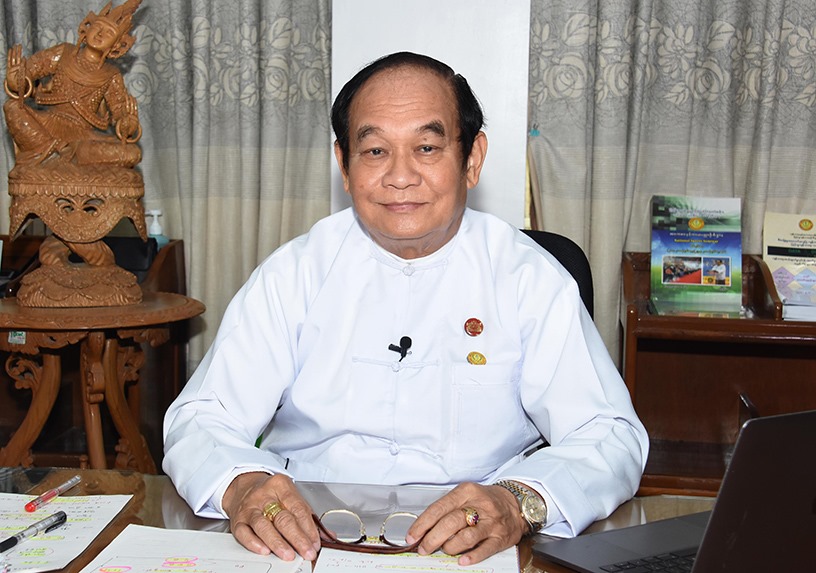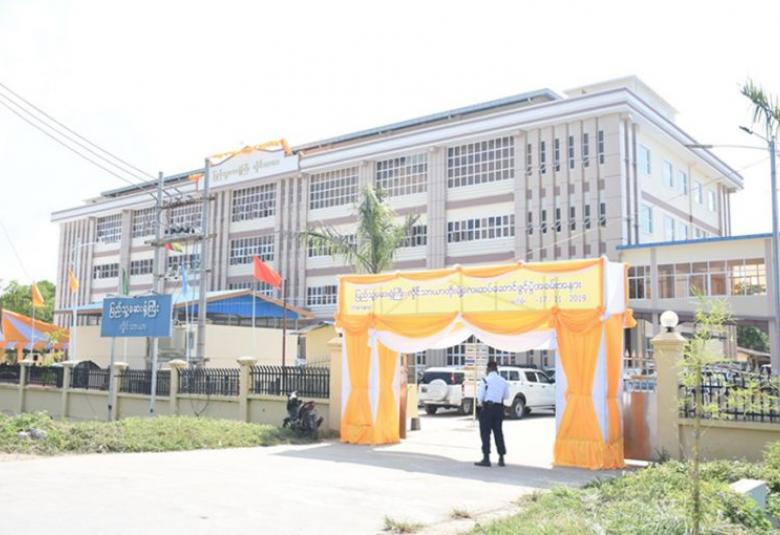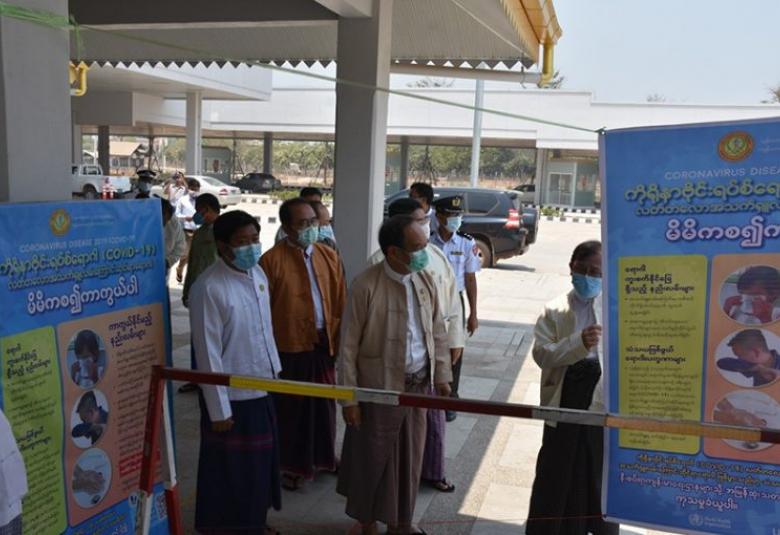28 April
By Nandar Win, Photo Soe Min Tun
”The plan is on the agenda for the construction of the Centre for the Prevention and Control of Communicable Diseases. A draft bill is being submitted to the Hluttaw to amend the Prevention and Control of Communicable Diseases Law (1995) to be line with the current situation.”
Implementing in full speed, the Ministry of Health and Sports (MoHS) is shouldering the tasks to provide sustainable healthcare system that is accessible to all citizens anywhere in the country. During the time of incumbent government, two ministries have been integrated into one in the name of the Ministry of Health and Sports.
In top gear, the MoHS is concentrating over the tasks such as that of the construction and upgrading of healthcare facilities; that of nurturing quality healthcare human resources; that of the compilation of correct data and information; and that of the better finance and budget management.
With regard to the fourth-year achievements of the MoHS, the interview with the Union Minister Dr. Myint Htwe is conducted and presented to the esteemed readers.
Q: Kindly share us with the prioritized tasks of the MoHS during the fourth-year period.
A: The MoHS is implementing the National Healthcare Project (2017 – 2021) accessible to all citizens. Moreover, the national health policy adopted in 1993 is under consideration to amend as necessary. Furthermore, in accordance with the changing situation, the healthcare strategies and tactics have been updated.
Only with the enhanced public healthcare system, the entire health standard of the people could be in better condition. With the healthy society in the country, budget incurred for the treatment sector could be saved for buying modern and quality medical equipments for the nation.
During last financial year, varied tasks have been implemented such as that of health literacy of the public; that of patient safety; that of introducing e-government system; that of uplifting capacity of healthcare professionals with various approach.
Furthermore, the budget allocation of the government and the foreign aid assistances have been utilized in the best possible ways on all faceted of the health sector of the nation.
Q: Kindly explain us on the aspect of health sector development tasks.
A: The government has allocated more funds to the health sector. In 2015 – 2016 financial years, the budget allocation was MMK (680) billion, and the 2019 – 2020 financial years’ budget is being accorded with MMK (1,018) billion. It is good to witness that the foreign assistances stood at MMK (136) billion from previous MMK (82) billion.
Q: Please tell us about the capacity building programmes of the healthcare professionals.
A: Total approved strength of the MoHS is (202,486), and that (113,771) is being appointed so far. The current workforce stands out only at (56) per cent of the approved number.
Q: Tell us on the e – Governance System being in process.
A: All the departments under the MoHS are successfully providing healthcare services to the people in the format of e – Governance System. For instance, all the relevant data and information with regard to COVID – 19 are being uploaded on MoHS Website (www.mohs.gov.mm) and the social media. Timely dissemination of news is shared through “Geographic Information System vide “COVID – 19 Surveillance Dashboard” along with the necessary mappings.
Moreover, all the meetings, workshops, training courses, seminars, and conferences are available on “Paperless Workshop System” Website (www.event-mohs.gov.mm); the “MoHS Events” Mobile Application; and the “QR (Quick Response) Code”.
Mobile Tablets being installed with the health messages are distributed to (404) doctors and (10,792) healthcare professionals in townships / sub-townships of (7) states / regions. The remaining healthcare professionals numbering (16,545) would be entrusted with the tablets soon.
Since the outbreak of COVID – 19 in the PR China, available tablets are being handed over to the frontline doctors, who applied “Mobile Device Management System (MDM)” and report back the data and information collected.
Q: Please elaborate on the tasks of the Department of Medical Services.
A: In the whole of the country, there are (1,152) hospitals with a total of (55,394) beds. In 2019, a total of (798,439) surgeries have been conducted, and that major surgeries such as that of (1,027) events of open chest surgery; that of (5,877) cardiac surgeries; and that of (852) neurological surgeries.
The authorities have approved and allowed with legal permits for the functioning of the general practice private clinics, the special clinics, the laboratories, and the x – ray facility units in the private sector.
Blood supply has been successfully implemented with (194,522) blood units in one year.
At the National Laboratories in Yangon and in Mandalay, Bio-safety Level-2 Laboratory 4 units, and Bio-safety Level-3 Laboratory 2 units have been upgraded.
Q: Kindly share us on the Department of Public Health.
A: Public healthcare services are provided at the local primary healthcare units / mother and child healthcare units; the rural healthcare units; the rural healthcare branches across the country. New healthcare centers are being constructed and put into functioning.
Q: Share us on the information with regards to the Prevention and Control of Communicable Diseases.
A: The plan is on the agenda for the construction of the Centre for the Prevention and Control of Communicable Diseases. A draft bill is being submitted to the Hluttaw to amend the Prevention and Control of Communicable Diseases Law (1995) to be line with the current situation.
National Action Plan for Health Security – NAPHS (2018-2022) has been adopted and it is under implementation.
Furthermore, the National One Health Strategic Framework and Action Plan of Myanmar (2019-2023) is ongoing with momentum.
Q: Tell us on the fight against the HIV / AIDS, the tuberculosis, and the malaria disease.
A: Treatment with ART are provided at (397) units in the townships where the HIV cases have inflicted, covering (184,684) patients reaching to (77) per cent of the unfortunate persons. Treatments are also provided to other HIV related diseases. The Global Fund has provided with US$ (51) million for HIV sector in 2019.
Tuberculosis patients are also treated with much attention by identifying new patients covering (133,095). Drug resistant TB patients are also treated covering (2,581) patients. The Global Fund has assisted US$ (35 point 6) million for TB treatment in 2019.
Treatment of malaria is waging ahead in full swing, and the number of patients is shrinking and that the fatality was witnessed as (9) parsons only in 2019. The Global Fund has provided US$ (44) million for malaria sector in 2019.
Q: Please tell us on the non-communicable diseases (NCD).
A: With the intervention of (11) projects, the non-communicable diseases are being prevented and reduced, and that the “NCD Risk Factor Reduction Task Force” has been formed. The campaign covers (232) townships with the tests and diagnosis of (1,288,037) patients.
Nurses and healthcare professionals handling cancer patients are being imparted with necessary training courses. Moreover, the “Injury Surveillance System” has been established.
Q: Kindly elaborate on the mother and reproductive healthcare system.
A: Maternal healthcare has been given full attention and that its coverage is enveloped to (97 point 8) per cent with skillful process of delivering a baby which stood as (82 point 8) per cent.
“One Stop Crisis Centre (OSCC)” has been formed at Nay Pyi Taw and Pin Da Ya People’s Hospital for handing the gender based violence, and that (119) victims have been salvaged.
Q: Tell us on the school healthcare measures.
A: The State Counsellor has spelled out seven-point guidelines to work out by the Ministry of Health and the Ministry of Sports. In line with the directives, tasks are being carried out such as that of the drug elimination at schools and universities; that of the free and clean surrounding of cigarettes, tobacco, betel leaves, nuts and alcohol; that of the creation of healthy life style ; and so on.
Q: Share us on the awareness raising measure on health knowledge.
A: It has been a success to say that the “Standardized Health Messages Book – Version 1.0” has been published and distributed. Moreover, the “Internet based Version 2.0” is also distributed for the use of the social media.
Healthcare news and information are being released to the public through government newspapers, the FM radios, and the government websites.
Most importantly, data and information with regard to COVID – 19 have been widely and thoroughly distributed in many ways and modes to the public.
Q: Kindly share us on the tasks with regards to human resources development.
A: Laws in connection with the degrees, diplomas and certificates have been duly enacted. M.Med.Sc. (Family Medicine) course has been drafted to apply in human resources development for the doctors.
With a view to nurture doctors in the remote areas of the country, new arrangements are being made by inducting (59) students at the medical universities who passed the Matriculation Examinations from the self-administered zones.
Q: Please tell us on the research programmes.
A: “Research Capacity Strengthening Training Centre” has been established at the Department of Medial Research in Pwin Oo Lwin. Certificate courses are provided at the centre for the personnel. With the intent to encourage the “Research Culture” in the country, a workshop for elevating research has been conducted for the first time in Myanmar Ministry of Health history.
At the 48th Myanmar Health Research Congress, many research papers have been submitted.
Q: Kindly explain on the measure for the safety of food and drugs.
A: The safety and quality of food, drugs, medical devices and cosmetics are undertaken by the Food and Drug Administration. The street vendors are provided with relevant training courses on safety and quality food at Nay Pyi Taw, Yangon and Mandalay.
With regard to the registration of drugs, the existing “e – submission system” has been updated and the relevant training course has been provided. For the safety of drugs in use, “Pharmacovigilance” Guideline has been issued to abide and follow by the drug companies and the healthcare professionals.
Food Microbiology Laboratory under the FDA has been awarded with ISO certificate in May 2019.
Q: Give us some information in connection with the traditional medicine.
A: The Department of Traditional Medicine has (44) traditional hospitals and (210) traditional healthcare centers across the country. In keeping the traditional medicine in systematic and orderly manner, “Training on Research Methodology” has been conducted for (60) trainees.
With a view to enhance the skills of the practitioners in the traditional medicine sector, the capacity building training courses have been organized for (13) occasions. Myanmar Traditional Medicine Council Law was enacted on 25 January 2019, and that the Patron Body of the council has been organized. It has exchanged MOU with the University of Toyama (Japan) and Yunnan University of Chinese Medicine (China).
Q: Please share us with the measures for the development of the sports sector.
A: The National Sports Seminar has laid down (73) suggestions for the development of sports sector, and that (19) recommendations have been taken up for implementation.
For the advantage of the people, total of (1,817) sets of “Outdoor Fitness Equipments” have been installed at states / regions.
In raising awareness and importance of the physical exercises, the “December sports activities” are organized every year and that (28,822,700) people participated in the campaign, covering (14) percent of the whole nation.
During the “Stay Home – Stay Safe” period due to COVID – 19 pandemic, home and indoor exercises for the young, the middle aged, and the elderly people have been uploaded on the websites of Sports and Physical Education Department.
Q: Please share us on the measures taken up in connection with the COVID -19 pandemic.
A: COVID – 19 pandemic is critical and serious issue. Since we heard the outbreak in PR China, the MoHS started necessary actions seriously with much attention at the entry / exit gates and the airports and the ports beginning 5 January 2020.
The main six-point suggestions released by the WHO have been implemented by the MoHS in time. On 11 March 2020, the WHO announced as the world pandemic, along with the recommendation to abide by the countries. The MoHS has carried out the suggestion in time.
While we were containing the spread of virus, the first positive case crept in on 23 March 2020, which happened to be the imported case.
This novel virus is in the same group with MER and SARS, however, the origin of the virus is uncertain, and that no one is aware of it. The MoHS has taken up the matter very seriously as we did not know about the origin of virus; its method of infection; and the incubation period.
Coordinate efforts in timely manners have been exerted in the public health perspective.
COVID – 19 Command Centre has been formed in time. We have abundant groups and teams working for the containment. The teams submitted data and information in connection with the ongoing prevention, containment and treatment taken up in other countries. We conducted video conferencing as necessary, which are very much instrumental and effective in our campaign.
In the treatment process, the “clinical management committees” have been formed in Yangon and in states / regions. We always keep in touch and discussed the possible approach in handling the pandemic. The professionals in the treatment sectors devoted heart and soul in the fight against the disease. The professionals in the public health sector are also diligent and poured out all energy in the prevention and containment tasks.
For the fight against the pandemic, cash assistances poured in such that of US$ (10) million from Gavi; that of US$ (4 point 5) million from Global Fund; that of US$ (700,000) from USAID; that of US$ (12) million from Access to Health Fund; that of US$ (200,000) from Asian Development Bank; that of US$ (6 point 5) million (loans) from the Asian Development Bank; and that of US$ (5) million (loans) from the World Bank. The government also provided profuse amount of budget in the fight against the pandemic. The MoHS is using the funds in proper and systematic manner, however, as many countries on this planet are also buying assortment of equipment and, we have some complexity in the procurement.
Here, I would like to express our thanks and gratitude to our people who take part in the charity and donation for the campaign.
Our current strategy in the campaign is to quarantine the effective persons and to keep the quarantine sites safe, which need proper management.
Another important practice is the use of hand-held loud speakers in disseminating relevant information to the public. According to survey, we came to know that it is really necessary to go around and announce the dos and don’ts to the public at least five times in a day.
As the State Counsellor chairs the central committee, the decisions are fast, speedy, and swift. We are carrying out the directives as have spelled out.
Another crucial factor is “contact tracing”, which must be properly handled, otherwise the pandemic would get worse.The people are earnestly advised to stay home until 30 April 2020.
Q: Give us some message for the public with regard to cooperation.
A: When the people stay at home in cooperation for certain period, without going outside, then the pandemic would naturally go away. At this juncture, people need to wash hands as much as possible.
Q: Tell us on the future plan.
A: We need to carry out the contact tracing, and restrict their movements. If necessary, we need to keep them at the hospital. Then the cases would slow down. Stay home until 30 April 2020, and put the mask when going out.
I am thankful to the senior physicians and the professionals, as they are stepping in the danger zones of the pandemic, risking their lives.We do not want anyone to die as it is a loss to the nation.
Q: Kindly add advice to the public.
A: For about (3) months we have been occupied with the fight against the COVID – 19. At this juncture, we need to be careful on other diseases such as diarrhea and dysentery, the influenza and the hemorrhagic fever. We have reminded our officers and staff members to properly spread out healthcare plans in this connection.
I would like to advise the public on six healthcare points of advice such as that of to take inoculation; that of the clean surrounding; that of personal hygiene; that of the learning on health knowledge through the healthcare workers; that of the avoiding on unhealthy food such as salty items and sweet snacks; that of avoiding cigarettes, tobacco and excessive alcohol, and drugs; and that of taking physical exercises.
In conclusion, I would like to say that the MoHS is endeavouring to spread the health literacy of the public, and that the people are strongly urged to comply with these recommendations. Translated by UMT (Ahlon)




